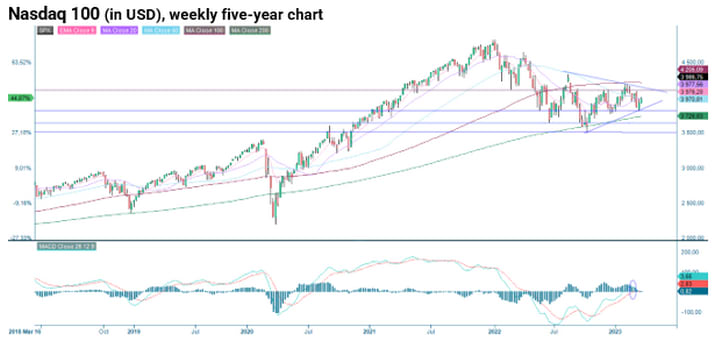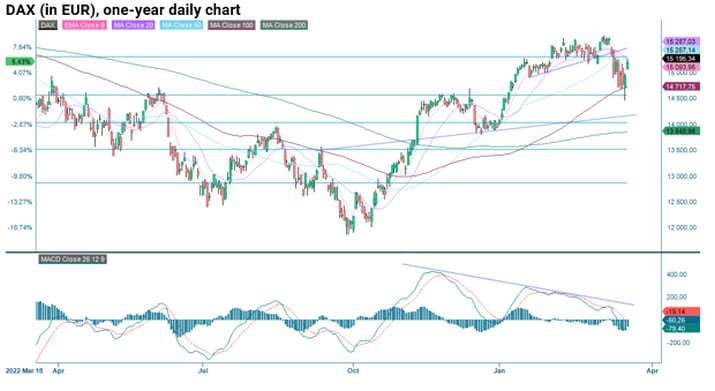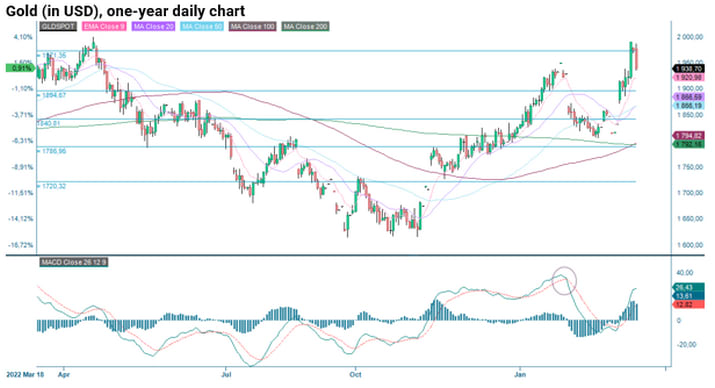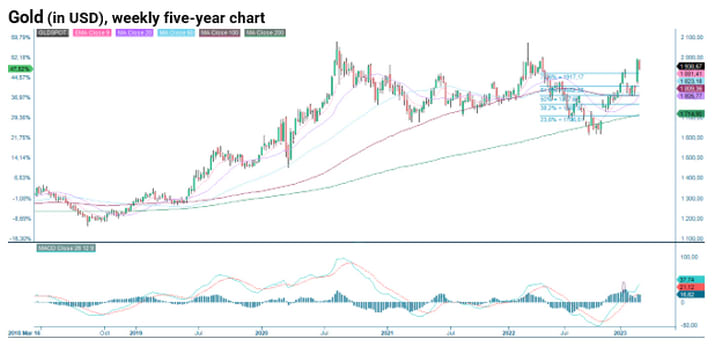Banking crisis lowers interest rate path

The burgeoning banking crisis has forced the Fed to increase its balance sheet to protect savers and the public. This could mean that we are now close to The Fed Pivot and that anticipated 25bp rate hike on the 22nd of March 2023 could be the last for a while. We also consider shares in stable Nordic banks such as Nordea and SEB attractive at current price levels.
Increased involvement of central banks in the rescue of banks
Equity markets continued to be pressured by the ongoing international banking concerns, with Credit Suisse at the epicentre. The situation was resolved on Sunday evening, 19 March, when UBS made a public bid for Credit Suisse worth around USD 3 billion. It was also announced on Sunday that five major central banks (the Fed, the Bank of England, the Bank of Japan, the ECB and the Swiss National Bank) had agreed on a coordinated action to increase market liquidity.

Credit Suisse share price graph (in CHF) in a five-year daily chart

Last week it was mainly the Fed's turn to prevent parts of the US banking system from collapsing. The eleven largest US banks announced on Thursday, 16th March, that they would jointly provide a USD 30 billion liquidity injection to the ailing First Republic Bank. That helped to boost market risk appetite, and the three major US stock indices rose.
After falling from around USD 9,000 billion to USD 8,350 billion over the past year, the Federal Reserve's balance sheet has risen by around USD 300 billion over the past week. That is a result of the problems in the banking sector.
As expected, the ECB raised its key rate by 50 basis points on Thursday, 16th March. The ECB raised its forecasts for economic growth and core inflation for 2023 but lowered its forecast for 2024. The message is that it will take longer to fight inflation, which justifies higher interest rates. The bank also said it has sufficient resources to provide European banks with the necessary liquidity.
Last week, the 2-year yield in the US, Germany and Sweden fell by around 50 basis points, mainly due to the banking turmoil.

However, the HYG ETF, with its underlying investments in US below-investment-grade ("junk") bonds, was not as severely affected by the banking turmoil events as had been feared. The falling rates helped as the value of bonds, in theory, increased as rates fell.
Focus on the Fed’s message today
The Fed is expected to deliver a 25bps rate hike on Wednesday, 22 March. The focus is likely to be on Powell's message, whether soft or hawkish. The US bank sector in March prompted the Fed to increase its lending to US banks and consider the financial stability of the US banking system. After last week's volatile trading for fixed income, the market is now pricing in a 20bp Fed hike and subsequent rate cuts in the second half of 2023. But bonds have also been one of several havens for investors in recent weeks, pushing down interest rates.
Friday, 24th March, will see the release of the March Industrial Purchasing Managers' Indices (PMIs) from Japan, France, Germany, the UK and the US. For Germany, the consensus forecast is for an improvement in the PMI to 47.0 from 46.3 in February. For the US, expectations are for a reading of 47.6 this time, up from 47.3 in February.
Will the short-term rising trend last in the US stock indices?
The strong communication from the central banks helped the indices to regain ground. US S&P 500 bounced nicely off support at 3,800 and is trading back above MA20. Also, note that MACD has generated a soft buy signal. Will the short-term rising trend continue? If so, MA50 is currently at around 4,020, and the short and falling trendline is the next level on the upside. That is followed by the resistance around 4,100. The latter corresponds to a potential upside of 3.5%. However, if rates rise and the central banks’ communication softens, this may turn south again. The potential downside is relatively significant, currently at 4,6% down to 3,800. Thus, the risk/reward of this trade could be more beneficial. A more exciting point of entry would be after a break of 4,100. The Fed and its message is in focus.


Tech-heavy and relatively interest-sensitive, Nasdaq 100 is up 8.4% from its low on March 13. It is currently testing resistance between 12,500 och 12,800. A break up above the 13,000 level would be an attractive time to enter a long trade from a risk/reward point of view. But again, markets are shaky, so keep stop-losses tight.


Will the European indices close the gap versus the US?
The fall of Credit Suisse has caused the European indices to lag a nice bounce in the US stock market. DAX closed yesterday’s trading below important MA20. A break up above and the previous tops above 15,600 may be tested.


Banking-heavy OMXS30 has had a rough time and is now trying to retake the rising trendline. Next on the upside is a cluster of resistance levels around 2,195 and 2,215. First, EMA9 and MA100, around 2,150, need to be taken out of the way.


Gold seems to be a good hedge if things turn for the worse
As the European stock indices turned south, the gold price went in the opposite direction. As the mentioned focus is on the central banks that have been communicating a clear bullish message so far. But is this only the tip of the iceberg? If so, gold may continue to serve as a good hedge.


Case of the week: Nordic Banks: An Undervalued Opportunity Amidst Fear of a Bank Run?
The Nordic conventional banking sector has been hit hard by the collapse of the US-based Silicon Valley Bank and the compulsory acquisition of Credit Suisse. The collapse of SVB in the US caused a ripple effect throughout the tech industry, leading to a sell-off in many technology-related stocks. As a result, many investors also sold their holdings in conventional Nordic banks, even though they had no direct exposure to the tech industry. The Swiss bank has been struggling with losses and scandals in recent years, and its acquisition by a local competitor has raised concerns about the overall health of the banking industry.
Despite this fear, the Nordic banking sector remains well-regulated and profitable. Nordic banks are also known for their conservative lending practices and diversified loan portfolios, which have helped them weather economic downturns in the past. Before the recent volatility, investor sentiment towards Nordic banks has been increasingly favourable over the last twelve months due to their stable loan portfolio in an increasing interest rate environment, thus also improving the profitability outlook in the Nordic sector.
However, those investors that have yet to be included in the 2022 bank rally now could have an opportunity to catch up with the lost ground and capitalise on current valuations in the sector. Given the low-interest rate environment in the Nordics, valuations for Nordic banks have become relatively low in comparison to European peers. Nordea's P/E ratio is only 10x. Similarly, SEB Group's P/E ratio is only 10.4x.
Fears of a classic bank run are likely overblown. While the collapse of Silicon Valley Bank and the acquisition of Credit Suisse have impacted investor sentiment towards Nordic banks, the sector’s underlying fundamentals remain strong. Yesterday, Nordea´s stock price started to bounce back after falling two days from its peak of 133 SEK per share Currently, the stock is trading roughly 10% lower than the Thursday levels.


The full name for abbreviations used in the previous text:
EMA 9: 9-day exponential moving average
Fibonacci: There are several Fibonacci lines used in technical analysis. Fibonacci numbers are a sequence of numbers in which each successive number is the sum of the two previous numbers.
MA20: 20-day moving average
MA50: 50-day moving average
MA100: 100-day moving average
MA200: 200-day moving average
MACD: Moving average convergence divergence
Risks
External author:
This information is in the sole responsibility of the guest author and does not necessarily represent the opinion of Bank Vontobel Europe AG or any other company of the Vontobel Group. The further development of the index or a company as well as its share price depends on a large number of company-, group- and sector-specific as well as economic factors. When forming his investment decision, each investor must take into account the risk of price losses. Please note that investing in these products will not generate ongoing income.
The products are not capital protected, in the worst case a total loss of the invested capital is possible. In the event of insolvency of the issuer and the guarantor, the investor bears the risk of a total loss of his investment. In any case, investors should note that past performance and / or analysts' opinions are no adequate indicator of future performance. The performance of the underlyings depends on a variety of economic, entrepreneurial and political factors that should be taken into account in the formation of a market expectation.
Disclaimer:
This information is neither an investment advice nor an investment or investment strategy recommendation, but advertisement. The complete information on the trading products (securities) mentioned herein, in particular the structure and risks associated with an investment, are described in the base prospectus, together with any supplements, as well as the final terms. The base prospectus and final terms constitute the solely binding sales documents for the securities and are available under the product links. It is recommended that potential investors read these documents before making any investment decision. The documents and the key information document are published on the website of the issuer, Vontobel Financial Products GmbH, Bockenheimer Landstrasse 24, 60323 Frankfurt am Main, Germany, on prospectus.vontobel.com and are available from the issuer free of charge. The approval of the prospectus should not be understood as an endorsement of the securities. The securities are products that are not simple and may be difficult to understand. This information includes or relates to figures of past performance. Past performance is not a reliable indicator of future performance.
